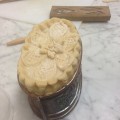
‘If you plant one apple only let it be Bramley’s’ Henry Merryweather
The Bramley apple is famous and much-loved throughout the world for its unique flavour and excellent cooking qualities. It remains one of the most widely grown British culinary apples, but did you know it originates from one of the prettiest towns in Nottingham – Southwell? and that every Bramley tree in existence is the offspring of one single tree which grew in the garden of a cottage in Church Street, Southwell since before the Battle of Waterloo.
Saturday 25th October sees the village celebrate the UK’s favourite cooking apple in its home-town. Whether you’re a serious foodie, or just after a fun day out, the Bramley Apple Festival, which attracts hundreds of local, national and international visitors is for you.
A Food and Drink Festival is held in the stunning Southwell Minster and incorporates all manner of apple-related products, fruit specialists and craftsmen. There will be apple related competitions – Young Bramley Chef of the year competition, poetry, apple pie baking, men’s baking, children’s baking, craft and photography competitions and even Morris dancing.
Throughout the town shops, businesses, Southwell Library, cafes, restaurants and local pubs will be taking part in the occasion.
Every year, people gather in the picturesque market town where the apple was first propagated more than 200 years ago. Around 1809, a young girl, Mary Ann Brailsford, planted some pips left over when her mother was preparing apples for cooking. One of the pips germinated, and when it became too big for its pot, was planted out in the garden, growing into a tree. In 1846, the cottage was bought by a Mr Mathew Bramley, together with one special apple tree in the garden.
In 1856, 17-year-old Henry Merryweather, was working at his father’s nursery in Hallam Road, Southwell, when he met George Musson, gardener to the Vicar of Southwell Minster, who was carrying a basket of apples. Learning they were from Mathew Bramley’s garden, he went to see the old man and was allowed to take grafts from the tree, on the provision that if anything came from it they would bear his name, from there he went on to build up a large stock of trees. The apple was first exhibited before the Royal Horticultural Society’s Fruit Committee in 1876, when it was highly commended. It went on to receive First Class certificates at subsequent shows, and was widely acclaimed as the finest cooking apple ever produced.
The robust and unfussy apple which will keep through winter until the following May is loved by cooks for its crisp clear flavour.
Nottingham used to have a reputation for good batter puddings. The traditional recipe below, taken from the Nottinghamshire Edition of ‘Our local food’ by Angela Geary, is a combination of crisply baked batter and Bramley apples and is a simple yet delicious autumnal dessert.
Nottingham Pudding
2 medium-sized Bramley apples.
1 & half oz butter
1 & half oz caster sugar
1 tsp sweet mixed spice
3oz plain flour
2 eggs
1/4 pint milk
Pinch of salt
Pre-heat the oven to 180c/350f
Butter 2 deep oven proof dishes
Peel and core the apples, leaving them whole.
Place an apple in each dish
Cream the butter, sugar and spices together, and fill the centres of the apples with the mixture.
To make the batter. Sieve the flour and salt into a mixing bowl. Make a well in the centre and add the eggs. Beat the eggs, gradually drawing in the flour, and adding the milk a little at a time, until you have a smooth batter.
Pour the batter over the apples and bake for approx one hour until the apples are soft and the batter is well risen, golden and crisp.
Serve straight from the oven, pouring over a little single cream
Ours wasn’t the prettiest attempt but it tasted great.
By Tanya Raybould




